

Radio Waves from Brown Dwarf Discovered. An artist's impression of a brown dwarf similar to J1047+21.

Using the radio telescope at Arecibo, Puerto Rico, a team of astrophysicists from Penn State have discovered radio emissions from a brown dwarf in the constellation Leo. 33.6 light years away, this ultra-cool star, named J1047+21, is only 5 times hotter than Jupiter. Penn State astronomers using the world’s largest radio telescope, at Arecibo, Puerto Rico, have discovered flaring radio emissions from an ultra-cool star, not much warmer than the planet Jupiter, shattering the previous record for the lowest stellar temperature at which radio waves were detected.
The team from Penn State’s Department of Astronomy and Astrophysics and the Center for Exoplanets and Habitable Worlds, led by Alex Wolszczan, the discoverer of the first planets ever found outside our solar system, has been using the giant 305-meter (1000-foot) telescope to look for radio signals from a class of objects known as brown dwarfs. Source: Penn State University. Space News - 2014 Articles About NASA and Space.
Your Age on Other Worlds. Want to melt those years away?
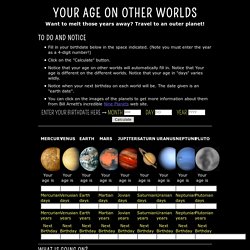
Travel to an outer planet! <div class="js-required"><hr> This Page requires a Javascript capable browser <hr></div> Mystery over the giant cosmic explosion of 774AD, which has left absolutely no trace - except deep within the rings of two cedar trees. By Eddie Wrenn Published: 12:10 GMT, 4 June 2012 | Updated: 16:39 GMT, 4 June 2012 The clues are in these rings: The rings capture microcosmic traces of particles in our skies - and tell us an explosion occurred It is a mystery which is truly beyond even Sherlockian scale - a cosmic explosion which left no trace behind except deep within the bark of two cedar trees.
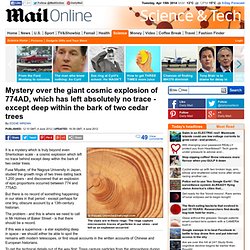
Fusa Miyake, of the Nagoya University in Japan, studied the growth rings of two trees dating back 1,200 years - and discovered that an explosion of epic proportions occurred between 774 and 775AD. But there is no record of something happening in our skies in that period - except perhaps for one tiny, obscure account by a 13th-century historian. The problem - and this is where we need to call in Mr Holmes of Baker Street - is that there should be a record. Carbon-14 forms when cosmic rays - generally caused by massive solar flares, or by supernovae - interact with nitrogen and oxygen in our atmosphere. Great Discoveries Channel: Sci, Space, Tech. Sir Bernard Lovell who founded Jodrell Bank Observatory dies aged 98.
HubbleSite - Out of the ordinary...out of this world. 10 popular misconceptions about astronomy explained. With the return of the brilliant planet Venus to our evening sky, I'm reminded of an amusing anecdote related by a good friend of mine, George Lovi, a well-known astronomy lecturer and author who passed away in 1993.
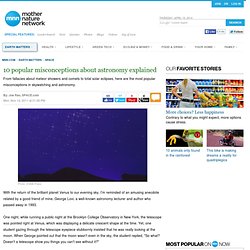
One night, while running a public night at the Brooklyn College Observatory in New York, the telescope was pointed right at Venus, which was displaying a delicate crescent shape at the time. Yet, one student gazing through the telescope eyepiece stubbornly insisted that he was really looking at the moon. When George pointed out that the moon wasn't even in the sky, the student replied, "So what? Doesn't a telescope show you things you can't see without it? " That story got me thinking about a number of popular misconceptions in astronomy. 1. Night Sky Constellations Naming History. There are 88 officially recognized constellations in the sky, and these astronomical patterns have a fascinating and long history.
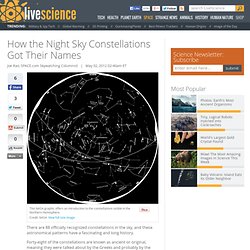
Forty-eight of the constellations are known as ancient or original, meaning they were talked about by the Greeks and probably by the Babylonians and still earlier peoples. After the 15th century, with the age of the great discoveries and worldwide navigation, the southernmost parts of the sky became known to man and had to be charted. Furthermore, across the entire sky were large gaps filled chiefly with dim stars between them. In more recent times people have invented the modern constellations to fill up some of these spaces. Saving space science - do you Uwingu? - Bad Astronomy.
Space science is in a tight spot today.
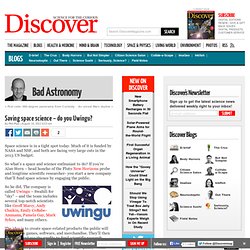
Much of it is funded by NASA and NSF, and both are facing very large cuts in the 2013 US budget. So what’s a space and science enthusiast to do? If you’re Alan Stern – head honcho of the Pluto New Horizons probe and longtime scientific researcher- you start a new company that’ll fund space science by engaging the public. So he did. The company is called Uwingu – Swahili for "sky" – and the team includes several top-notch scientists like Geoff Marcy, Andy Chaikin, Emily CoBabe-Ammann, Pamela Gay, Mark Sykes, and many others.
The idea is to create space-related products the public will like such as games, software, and merchandise. Right now they’re just starting it up, and they need cash to get it rolling – getting an accountant, paying for server support, and the like. At the moment they’re not giving out specifics about the sorts of merchandise and apps they’ll have, because they’re trying to build a little suspense. Related Posts: Guide to Space. By Matt Williams on April 24, 2008.
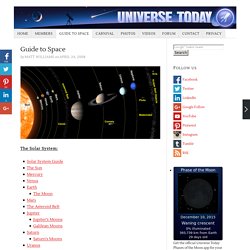
Nasa NuStar telescope dropped from plane: Rocket powered device soars into space. By Eddie Wrenn Published: 08:39 GMT, 13 June 2012 | Updated: 06:50 GMT, 14 June 2012 NASA has launched its latest X-ray space telescope on a two-year hunt for black holes lurking in the heart of the Milky Way and other galaxies.
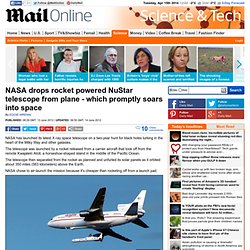
The telescope was launched by a rocket released from a carrier aircraft that took off from the remote Kwajalein Atoll, a horseshoe-shaped island in the middle of the Pacific Ocean. The telescope then separated from the rocket as planned and unfurled its solar panels as it orbited about 350 miles (563 kilometers) above the Earth. NASA chose to air-launch the mission because it's cheaper than rocketing off from a launch pad. Launching from a plane: NASA's NuSTAR satellite launched from a Pegasus rocket carried on an Orbital plane (previous launch pictured)
Can humanity cope with long-term space travel? Scans reveal damage to brains and eyes in astronauts. MRI tests on travellers to International Space Station uncover effects on eyeballs and brain connectionsMission to Mars may not be possibleHumanity's ability to get to and settle on another planet may also be a non-runner By Eddie Wrenn Published: 10:57 GMT, 13 March 2012 | Updated: 16:20 GMT, 13 March 2012 Brain scans of NASA astronauts who have spent more than a month in space have revealed damage to their eyeballs and brain tissue.
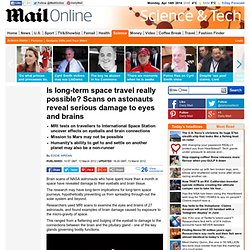
Astronomy News. The beautiful 3D map of space that plots our nearest galaxies - and reminds us how tiny Earth is. French researchers have created 3D representations of what our local universe looks likeIt centres around the Milky Way and Andromeda but extends up to 3,000 million light years awayBy plotting the universe, astronomers can learn more about how galaxies form By Victoria Woollaston.
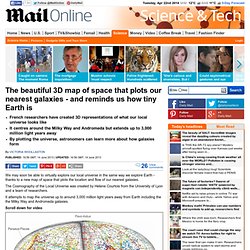
Courses in Astrophotography.